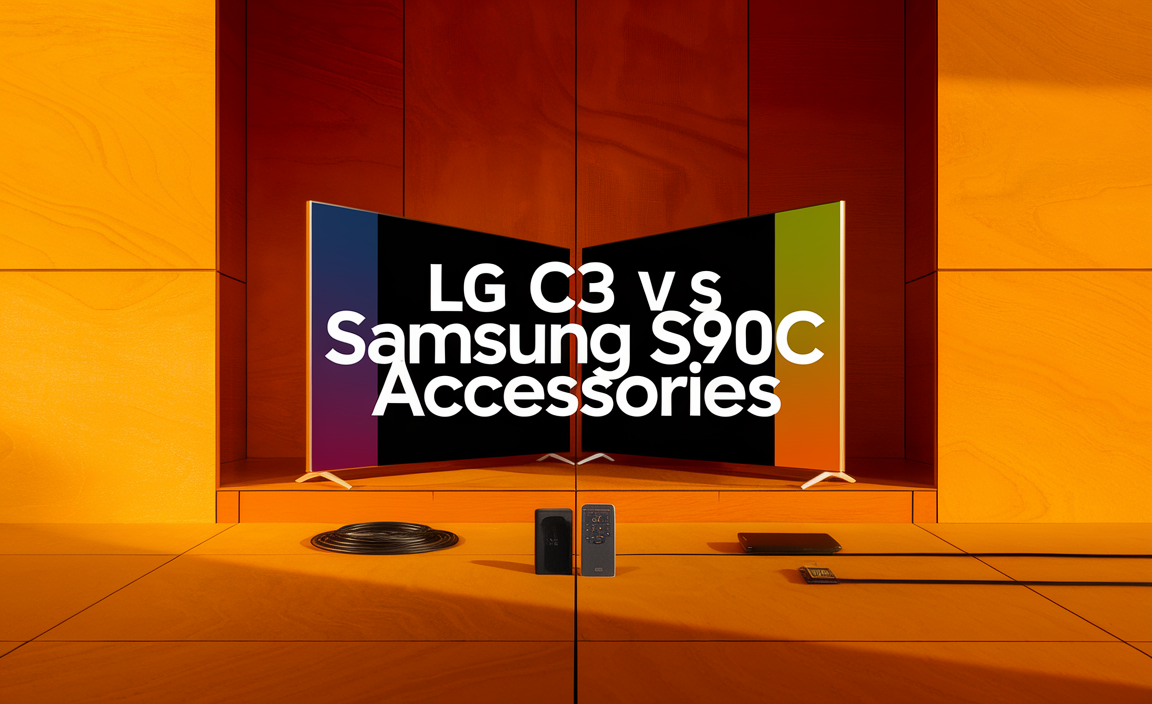Quick Summary
The best TV for a bright room needs a high peak brightness and excellent anti-glare properties to combat reflections and maintain vibrant picture quality. Look for QLED or OLED TVs with advanced screen coatings and utilize features like Full Array Local Dimming for deeper blacks. Our guide breaks down what to look for so you can enjoy your TV, no matter the lighting conditions.
Is your TV experience dim even when the sun is shining bright? You’re not alone! Many of us have living rooms or home offices that get a lot of natural light, and this can make watching TV a real challenge. Glare washes out colors, dark scenes become hard to see, and sometimes it feels like you’re fighting against the room itself. But don’t worry, finding the perfect TV for a bright space is totally achievable. We’ll walk through exactly what makes a TV shine in a sunny room and how to choose the right one for you. Get ready to upgrade your viewing!
Why Bright Rooms Are a TV’s Kryptonite
It’s a common problem: you settle in to watch your favorite show, but a glare from the window obliterates half the screen. Bright ambient light, whether from sunlight or indoor lamps, can significantly degrade your TV viewing experience. This happens because the light reflecting off the screen competes with the light the TV is producing. The TV’s own picture can get washed out, making colors look dull and black levels appear more like shades of gray.
This struggle is particularly noticeable during darker scenes in movies or games. Instead of seeing rich details in shadows, you might just see a murky mess. The contrast ratio, a key factor in picture quality, is severely impacted by reflections. What might look like a stunning 4K image in a dark room can become a disappointing blur when daylight hits it.
What to Look For: The Bright Room TV Essentials
Choosing the right TV for a bright room isn’t just about picking the biggest screen. Several key technologies and features work together to ensure your TV looks its best, even when bathed in light. Understanding these will help you navigate the spec sheets and make an informed decision.
1. Peak Brightness: The Bigger, The Better
This is arguably the most crucial spec for a bright room. Peak brightness is measured in nits (or candelas per square meter, cd/m²). A higher nit rating means the TV can produce a brighter image, which is essential to overcome ambient light and maintain picture vibrancy. For a bright room, you’ll want a TV that can reach at least 1000 nits, and ideally 1500-2000 nits or more for truly exceptional performance.
- Why it matters: Higher brightness allows the TV’s picture to “push back” against light reflecting off the screen, making colors pop and details visible even in well-lit conditions.
- What to aim for: Look for TVs advertised with high peak brightness figures, often found in premium models.
2. Effective Anti-Glare & Reflection Handling
Even the brightest TV can be ruined by a persistent glare. The screen’s surface finish plays a massive role. Matte or anti-glare coatings are designed to diffuse light, scattering it less intrusively than a glossy screen. Glossy screens can make reflections look like sharp, distracting mirrors of your room.
- Screen finish: Look for terms like “anti-glare,” “matte finish,” or “low-reflection screen.”
- Coating technology: Some manufacturers use specialized optical filters and coatings that are highly effective at reducing reflections.
3. Contrast Ratio & Black Levels: Fighting the Wash-Out
A high contrast ratio means the difference between the brightest whites and the darkest blacks a TV can produce is significant. In a bright room, this difference can easily be diminished by ambient light. Technologies that enhance black levels, like local dimming, become very important to prevent dark scenes from appearing gray and lifeless.
- Local Dimming: Features like Full Array Local Dimming (FALD) or Mini-LED backlighting allow different zones of the screen to be dimmed or brightened independently. This helps create deeper blacks and better contrast, even with ambient light present.
- OLED vs. LED: While OLED TVs offer perfect blacks, they can sometimes struggle with peak brightness compared to high-end LED (especially QLED or Mini-LED) TVs. However, modern OLEDs are improving their brightness significantly.
4. Color Accuracy & Vibrancy
When light washes over a screen, colors can lose their punch. A TV with a wide color gamut and good color processing will do a better job of maintaining vibrant and accurate colors even in bright conditions. Technologies like Quantum Dots (found in QLED TVs) are excellent at producing a wide spectrum of colors that remain vivid.
- Wide Color Gamut: Look for terms like DCI-P3 coverage (e.g., 90% or higher DCI-P3) to ensure the TV can produce a broad range of colors.
- HDR Support: High Dynamic Range (HDR) formats like HDR10, HDR10+, and Dolby Vision require a TV to be able to display a wider range of brightness and color. A TV that handles HDR well is often a good bet for bright rooms.
Understanding TV Technologies for Bright Rooms
Different types of TV panels and backlighting technologies offer varying strengths when it comes to handling bright environments. Let’s break down the most common ones you’ll encounter.
QLED (Quantum Dot LED) TVs
QLED TVs are a type of LED TV that use quantum dots – tiny semiconductor crystals – to enhance color and brightness. These dots emit specific colors when light shines on them, leading to more vibrant and accurate hues. Most importantly for bright rooms, QLED TVs can achieve very high peak brightness levels.
- Pros for bright rooms:
- Excellent peak brightness, often surpassing 1000 nits and sometimes reaching 2000+ nits.
- Vibrant color reproduction, which holds up well under ambient light.
- Often feature excellent anti-glare coatings.
- Cons:
- Black levels, while good, may not be as perfect as OLED due to the LED backlight.
- Can be more expensive than standard LED TVs.
OLED (Organic Light-Emitting Diode) TVs
OLED technology is famous for its perfect blacks and infinite contrast ratio because each pixel emits its own light. This means when a pixel is “off,” it’s truly off. While this is amazing for dark-room viewing, traditional OLEDs have had limitations in peak brightness compared to QLEDs. However, newer generations of OLEDs are significantly brighter and come with advanced features.
- Pros for bright rooms:
- Deep, true blacks which help maintain contrast even with some ambient light.
- Excellent viewing angles, so the picture stays good from off-center positions.
- Modern OLEDs are much brighter than older models, with some now rivaling QLED in certain scenarios.
- Cons:
- Can still be outshone by the brightest QLED TVs in extreme lighting conditions.
- Can be susceptible to glare if they have a very glossy screen without strong anti-reflective coatings.
- Generally the most expensive option.
Mini-LED TVs
Mini-LED is an advanced form of LED backlighting. Instead of a few hundred LEDs, Mini-LED TVs use tens of thousands of tiny LEDs to control backlighting. This allows for more precise local dimming, leading to better contrast, deeper blacks, and often higher peak brightness compared to traditional LED TVs. Many QLED TVs now incorporate Mini-LED technology.
- Pros for bright rooms:
- Exceptional brightness and contrast due to precise local dimming.
- Good for HDR content, which benefits from bright highlights.
- Often come with effective anti-glare screens.
- Cons:
- Can sometimes exhibit blooming (halo effect) around bright objects on a dark background, though this has improved with newer models.
- Can be pricier than standard LED TVs.
Standard LED/LCD TVs
These are the most common and generally most affordable TVs. They use an LED backlight to illuminate an LCD panel. While many are perfectly adequate, they often lack the peak brightness and advanced local dimming features needed to truly excel in very bright rooms compared to their more premium counterparts. However, some higher-end standard LED TVs can still perform admirably.
- Pros:
- Most affordable option.
- Wide variety of sizes and models available.
- Cons:
- Lower peak brightness compared to QLED and Mini-LED.
- Contrast can be poor, with blacks appearing more gray, especially in bright rooms.
- Reflection handling can vary significantly.
Key Features to Double-Check When Buying
Beyond the panel types, several specific features can make or break a TV’s performance in a bright environment. Here’s what to keep an eye out for:
Screen Coating Effectiveness
This is your first line of defense against glare. Look for detailed reviews that specifically test anti-glare performance. Manufacturers use various terms, but the practical effect is what matters – how well does it diffuse or prevent reflections from becoming distracting?
Local Dimming Performance
For TVs that aren’t OLEDs, effective local dimming is crucial for maintaining contrast. Full Array Local Dimming (FALD) with a good number of dimming zones is ideal. Mini-LED backlighting typically offers some of the best local dimming performance available.
HDR Performance
While HDR is about an extended range of brightness and color, a TV’s ability to deliver impactful HDR is closely tied to its peak brightness and contrast. A TV that handles HDR well usually has the underlying power—high brightness and good black level control—to be a strong contender for bright rooms.
Room Lighting Optimization Settings
Some TVs have built-in sensors that can adjust picture settings automatically based on the ambient light in your room. Features like an “Eco Mode” or “Ambient Light Sensor” can help, though manual adjustments are often still needed for the best results.
It’s also helpful to understand how your room lighting works. For example, controlling natural light with blinds or curtains can make a significant difference. For more on managing light in your home theater setup, the U.S. Department of Energy offers insights into optimizing natural light.
Recommended TVs for Bright Rooms (Examples)
While models change yearly, here are some types of TVs that consistently perform well in bright environments:
High-End QLED/Mini-LED TVs: Brands like Samsung (Neo QLED series) and TCL (QM8, Q7 series) often have models offering extremely high peak brightness and excellent anti-glare coatings. These are typically top contenders. LG’s QNED series also falls into this category.
Premium OLED TVs: Newer OLED models from LG (G3, C3 series) and Sony are pushing brightness boundaries and often feature improved anti-reflective coatings. While not always the brightest overall, their perfect blacks and improved light handling make them viable for many bright rooms, especially if glare is managed.
Good Value Options: Some of Hisense’s ULED models or higher-tier TCL sets can offer a good balance of brightness and reflection handling at a more accessible price point.
What determines the “Best”? The “best” TV will always depend on your specific room, budget, and viewing habits. However, prioritizing peak brightness, anti-glare capabilities, and strong contrast is key for any bright-room purchase.
Setting Up Your TV for Optimal Bright Room Viewing
Once you’ve got your TV, a few setup tweaks can make a world of difference in a bright environment.
1. Strategic Placement
Avoid direct sunlight: Position your TV so that direct sunlight doesn’t hit the screen, especially during peak viewing hours. If this isn’t possible, consider window treatments (blinds, curtains) to diffuse or block direct light.
Minimize overhead lights: If you have bright ceiling lights directly above or in front of the TV, try to dim them or turn them off when watching.
2. Picture Mode Settings
Vivid/Dynamic Mode: These modes often boost brightness and saturation, which can be beneficial in a bright room. However, they can sometimes sacrifice color accuracy. Use them as a starting point and adjust to your preference.
Standard/Cinema Mode: While these modes are great for accuracy in controlled lighting, they might be too dim for a bright room. You’ll likely need to increase the brightness and contrast settings manually.
Brightness and Contrast Adjustments: Manually increase the “Brightness” and “Contrast” settings. Be careful not to set “Brightness” too high, as it can crush shadow detail. Boost “Contrast” to enhance the image’s punch.
3. Utilizing TV Settings Effectively
Ambient Light Sensor: If your TV has an ambient light sensor, enabling it can help the TV automatically adjust its brightness based on surrounding light levels. This is a convenient feature but might not always provide the perfect picture.
Gamma Settings: Adjusting gamma can affect how the TV handles different shades of gray. In a bright room, you might need to experiment with gamma settings to ensure that darker imagery doesn’t get completely lost.
Color Temperature: A warmer color temperature (more red) can sometimes make the picture appear more pleasing in bright light than a cooler, bluer tone. Experiment with the settings.
4. Controlling Reflections
Window Treatments: As mentioned, blinds or blackout curtains can dramatically reduce glare from windows. Consider light-filtering blinds that allow some light in while diffusing it.
Paint Colors: While a larger change, lighter or neutral wall colors in a room can reflect more light, potentially competing with the screen. Darker or matte finishes on walls and furniture can absorb more light.
Table: TV Technologies Compared for Bright Rooms
| Technology | Peak Brightness Potential | Reflection Handling | Contrast/Black Levels | Color Vibrancy | Best For What? |
|---|---|---|---|---|---|
| QLED | Very High (1000-2000+ nits) | Good to Excellent (often with anti-glare coatings) | Good to Very Good (with FALD/Mini-LED) | Excellent | Bright rooms where maximum impact and vibrant colors are desired, balancing performance and reflection control. |
| OLED | Good to High (800-1300+ nits in newer models) | Varies (can be glossy or have anti-reflective layers) | Perfect | Very Good | Bright rooms where perfect blacks are paramount, and users are willing to manage potential glare through placement or treatments. Newer, brighter OLEDs are excellent all-rounders. |
| Mini-LED (often found in QLEDs) | Very High (1000-2000+ nits) | Good to Excellent | Excellent (superior local dimming) | Excellent | Bright rooms needing incredible lighting control, deep blacks, and brilliant highlights. Often the top tier for bright environments with HDR. |
| Standard LED/LCD | Moderate (300-600 nits) | Varies (can be poor) | Fair to Good | Good | Budget-conscious buyers in moderately bright rooms, where extreme brightness isn’t a primary concern. |
FAQs About TVs for Bright Rooms
Q1: Do I really need a super bright TV for a bright room?
Yes, absolutely. A TV with a high peak brightness (1000 nits or more) is crucial. It helps the TV’s picture overpower the ambient light, ensuring colors remain vibrant and details are visible without the screen looking washed out by reflections.
Q2: Are OLED TVs bad for bright rooms?
Not necessarily anymore. While historically OLEDs weren’t as bright as QLEDs, newer models have significantly improved their peak brightness. Their perfect blacks remain a huge advantage. However, you’ll want to ensure the specific OLED model has good anti-glare coatings and consider managing reflections in your room.
Q3: What’s more important: brightness or anti-glare coating?
Both are critical. High brightness allows the TV to compete with ambient light, while an effective anti-glare coating








